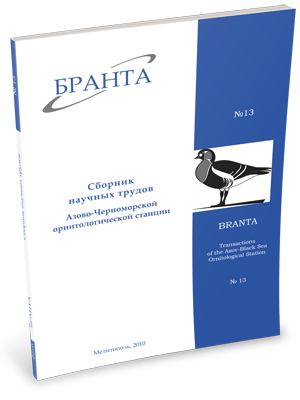
Transactions
of the Azov-Black Sea Ornithological Station



Extreme falls of temperature as a factor of formation of hydrophilic birds winterings in the South Crimea.
M. M. Beskaravayny
The paper analyses the characteristics of development and existence of winter hydrophilic ornithocomplex in the South Crimea during extreme falls of temperatures in the North Black Sea area.
Material and methods. The material was collected over the period 1980-2010 гг. in the south of Crimea (southern Crimean coast, vicinity of Feodosia and Sevastopol). The marine waters (250 counts including 60 in cold snaps) and several late-freezing inland water bodies were investigated.
Climate backgrounds of extreme winterings.Movements to southern regions, connected with freeze-up of waters are typical for bird wintering in the Crimea. Mean temperature in January for Sivash area is -1.7o to -2.3o, recurrence of low temperatures (-20…-25o) is 15-43% (Ivanov, Ivanova, 2000). The southern coast of the Crimea is the warmest climatic zone in Ukraine with mean January temperatures – +1.6o…+4o, minimum temperatures -13o…-25o, unstable snow-cover and sea waters that do not freeze.
Influence of temperature falls on a structure of hydrophilic ornithocomplex.
In extremely cold winters the role of South Crimea greatly grows for birds that had to change their wintering sites: it gives a shelter for species that usually do not winter there and, in addition, some regular winterers increase their number. Extreme winterings are usually formed in January-February. Significant fluctuations in numbers are traits of polyphages feeding on benthos and developing mass winter concentrations in the north of the Crimea (geese, coot) and euryphages (gulls).
Factors of spatial distribution of birds in the coastal zone.
The most diverse and numberous ornithocomplex is formed at sea waters (temporary habitat for 28 species). According to importance for extreme wintering the waters are distinguished in 4 types: deep waters at open coasts, shallows, in closed bays, at human settlements. The costal zone as a forage habitat is important only for few species; during snowfalls its ornithocomplex is added by species of tree-shrub and steppe avifauna. Coastal waterless areas are used by 7 species. A certain role is played by late-freezing water bodies (usually 13 species) and waterways.
Mortality of birds during extreme temperature falls. Falls of temperature are always followed by high bird mortality. In February 1985 the death of 28 species was proved. (Grinchenko, Kupsha 1999), in January 2006 and 2010 in the eastern part of the South Crimean and at Feodosia – 12 species. High mortality is typical for the Great Crested Grebe, Coot, Yelloe-legged Gull, swans.
Conclusions. With temperature falls in the North Black Sea area, at least 28 hydrophilic bird species move to southern regions of the Crimea. Such a forced wintering is always followed by high bird mortality. The base of winter hydrophilic ornithocomplex in the south is made up by species numerous in northern Crimean regions: benthosophages, trophically related to shallow waters, and also some euryphages (gulls). Large concentrations are formed at relatively shallow waters, in closed bays and at large settlements (FeodosiaBay, bays of GerakleyaPeninsulaetc.). During temperature falls 7 rare species are observed: large concentrations are formed by the Red-Crested Pochard and Goldeneye.
Read the paper in a PDF file